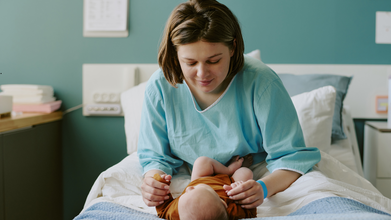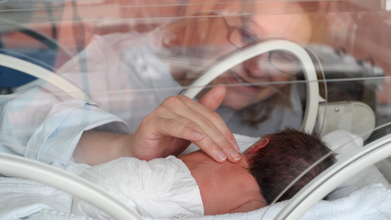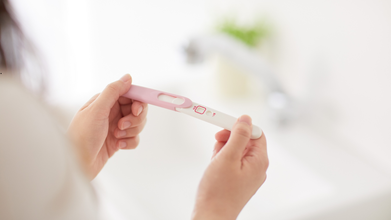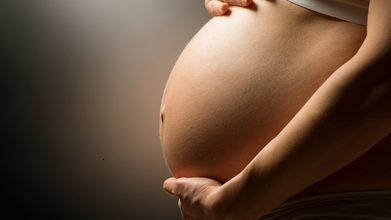- Health Conditions A-Z
- Health & Wellness
- Nutrition
- Fitness
- Health News
- Ayurveda
- Videos
- Medicine A-Z
- Parenting
Why Winter Is the Riskiest Season for Newborns, According to Doctor

Credits: Canva
Winter may feel refreshing for adults, but for newborns, it is one of the most vulnerable seasons of the year. Infants have immature immunity and cannot regulate their body temperature efficiently, making them prone to cold stress, infections, and breathing difficulties. In a conversation with Health and Me, Dr. Manju Kumari shared essential guidance for parents navigating their baby’s first winter.
Keeping Your Baby Warm
Newborns lose heat rapidly, and even a slight drop in temperature can lead to distress. Dr. Kumari explains that “infants cannot regulate their body temperature effectively, which is why small measures go a long way.”
She advises dressing babies in soft, light layers rather than one thick piece of clothing, as layering traps warmth better and prevents overheating. The head and feet should always be covered with a cap and socks since “heat loss is maximum from these areas.”
Parents must ensure the room is comfortably warm, especially during sleep time. However, loose blankets should never be placed over a baby’s face or neck. “This increases the risk of SIDS,” she notes. Bathing should also be brief—no more than 2–3 minutes, with warm (not hot) water and away from fans or cold drafts.
Preventing Infections During Winter
With colder weather comes a spike in viral infections, making newborns particularly vulnerable. “Their immunity is still developing, so simple precautions matter,” Dr. Kumari says.
Parents should:
- Limit visitors during the first weeks
- Wash hands before touching the baby
- Avoid anyone who shows symptoms of a cold or flu
- Keep the room ventilated to reduce indoor pollution
- Maintain a clean environment for feeding and sleeping
- Stay updated with vaccinations and follow pediatric advice
According to her, infection control begins at home, and these small actions significantly reduce a baby’s exposure to harmful germs.
Caring for Skin and Breathing
Winter dryness and pollution can irritate a baby’s delicate skin and airways. Dr. Kumari recommends using gentle, fragrance-free moisturizers and avoiding strong soaps.
Blocked noses are common, and she advises saline nasal drops only under a paediatrician’s guidance. She emphasizes keeping infants away from incense sticks, scented sprays, smoke from cooking, and heater fumes. “Their lungs are extremely sensitive. Clean air around a newborn is non-negotiable,” she says.
A dust-free, odor-free sleeping area is crucial for easy breathing and quality rest.
Warning Signs Parents Should Never Ignore
Recognizing distress early can prevent complications. Dr. Kumari lists key red flags:
- Fast or labored breathing
- Feeding poorly or refusing feeds
- Fever or unusually low temperature
- Sudden lethargy
- Pale or bluish skin
“If any of these signs appear, seek immediate medical attention,” she stresses. Early intervention can make all the difference in a newborn’s outcome.
Small Steps, Big Difference
Winter care, Dr. Kumari assures, “is not as complicated as it seems.” Thoughtful adjustments, appropriate clothing, safe sleeping practices, good hygiene, and close monitoring, can protect babies from most seasonal risks.
“With a warm, clean, and safe environment, parents can ensure their newborns thrive even in the cold months,” she concludes. These simple habits not only safeguard health but also make the early months more joyful and stress-free for new families.
What Parents of Premature Babies Must Know About the NICU, According to a Neonatologist

Credits: Canva
Every year on November 17, World Prematurity Day is observed, and this year, the global theme was 'Give preterm babies a strong start for a bright future'. The day is observed to raise awareness around premature birth, emphasize the importance of quality care, and advocate for better health outcomes for preterm infants and their families.
To understand how can one take better care of preterm babies, Health and Me spoke to Dr Sanjay Wazir, Medical Director, Neonatology and Pediatrics at Motherhood Hospitals, Gurugram.
Dr Wazir points out that at first the Neonatal Intensive Care Unit or the NICU may seem overwhelming, however, it must be seen as a sanctuary of healing. "In the NICU, premature or unwell newborns receive specialized medical attention, constant monitoring, and compassionate care from expert hands. Here, the mother and the baby are well taken care of. This will help the baby lead a healthy life. Hence, NICU care is important for all the premature or unwell babies," he says.
What The Parents Go Through?
Doctor rightly points out that for any parent seeing their babies in NICU could be frightening, especially seeing their child surrounded by wires, machines, or even incubator could trigger worry and confusion. However, he says that new parents should not fret or panic. He says that NICU is a place designed to give fragile newborns the best possible start in life. "Here, premature babies, those with low birth weight, or those needing medical support after delivery receive round-the-clock care from a dedicated team of neonatologists and nurses," he explains.
What Happens Inside The NICU?
The doctor explains that the NICU provides a controlled and nurturing environment where babies can grow stronger outside the womb. "It helps maintain their body temperature, supports breathing, and ensures proper nutrition through feeding tubes if necessary," he says.
Every machine in the NICU is for a specific purpose, right from oxygen support to heart rate monitoring, ensuring that each baby receives precisely what they need. Parents often find comfort knowing that the experts in the NICU are constantly watching over their child’s progress, explains the doctor.
The doctor points out that parents are essential part of the NICU journey. "Your touch, your voice, and your calm presence can help your baby feel safe and comforted," he tells to all the parents. However, what is extremely important is to maintain hygiene guidelines, staying involved in daily care, and communicating regularly with the doctors and nurses to "strengthen your bond and confidence as caregivers." The doctor says that during this time, the mother will also be taught about Kangaroo care, which is skin-to-skin contact that helps the mother bond with her baby.
Journey To Home
"Each beep and monitor in the NICU tells a story of progress. Some days may be tough, but the baby will be able to thrive after prompt attention," notes the doctor. While the experience can be emotional, parents must remember that the journey is also filled with hope. With expert care and a parent’s love, many premature and unwell babies go on to lead healthy, happy lives.
What Does Low AMH Mean For Parents Who Are Trying To Conceive?

Credits: Canva
Many women who are planning to start a family, the words “low AMH” can instantly trigger fear or confusion. AMH, or Anti-Müllerian Hormone, is commonly used as an indicator of ovarian reserve. This is the approximate number of eggs remaining in a woman’s ovaries. However, experts stress that a low AMH value does not mean pregnancy is impossible. With early diagnosis, the right treatment, and supportive lifestyle changes, women with low AMH can and do conceive successfully.
What Low AMH Actually Means
AMH levels naturally decline with age, especially after 30. According to Dr Varsha Agarwal, Consultant, Fertility & IVF Specialist at Motherhood Fertility & IVF, Noida, a low AMH value simply suggests that the number of available eggs may be lower than average. It does not assess the quality of the eggs, nor does it predict whether a woman can or cannot become pregnant.
Dr Agarwal explains that many women misunderstand AMH and assume that a low value is a final verdict on fertility. In reality, women with low AMH can still produce healthy eggs and can conceive either naturally or with medical assistance. “There is a lack of awareness when it comes to AMH,” she notes, adding that it is crucial not to rely on social media posts or forwarded messages that often fuel myths around fertility.
The key is early awareness, timely medical guidance, and personalized counselling so women can make informed choices about their reproductive health.
Treatment Options and Advanced Medical Support
Fertility treatments have become far more sophisticated and personalized today. Depending on age, AMH levels, and overall reproductive health, doctors may recommend approaches such as:
- Ovulation stimulation to support natural conception
- IVF (In Vitro Fertilization) for better egg retrieval and fertilization
- Egg freezing for women planning pregnancy later in life
Dr Agarwal emphasizes that many women with low AMH respond positively to these treatments. With careful monitoring, tailored protocols, and expert intervention, the chances of conception remain promising.
Alongside medical treatment, lifestyle also plays a crucial role. Maintaining a healthy weight, eating balanced meals, reducing stress, ensuring adequate sleep, and avoiding smoking or alcohol can improve reproductive outcomes. These habits support hormonal balance and egg health, enhancing the effectiveness of any fertility plan.
Being Proactive Matters
One of the most important steps women can take is to avoid delaying fertility evaluations—especially if they plan to conceive later in life. Low AMH should be seen as a signal to take proactive measures, not a reason to panic.
Dr Agarwal encourages women to prioritize regular check-ups, consult specialists early, and stay informed about their bodies. “Women need to take charge of their fertility health,” she says. “With expert guidance and timely intervention, the journey to motherhood is still very much possible.”
How To Manage Diabetes During Pregnancy? Here's What WHO's Guidelines Say

Credits: Canva
The World Health Organization (WHO) has released its first global guidelines dedicated specifically to the management of diabetes during pregnancy, a major milestone for maternal and newborn health. Diabetes affects one in six pregnancies worldwide, impacting nearly 21 million women every year, and the newly released recommendations aim to transform how this growing health challenge is recognized, treated, and prevented across all health systems.
Why Diabetes in Pregnancy Demands Urgent Attention
Diabetes during pregnancy, whether pre-existing or gestational, can be dangerous if not properly managed. Poor blood sugar control significantly raises the risk of pre-eclampsia, stillbirth, obstructed labor, birth injuries, and other complications. The long-term consequences are equally serious: both mothers and babies face a higher lifetime risk of type 2 diabetes, heart disease, and other cardiometabolic disorders.
The impact is especially severe in low- and middle-income countries, where women often lack access to early screening, essential medicines, glucose testing supplies, and specialized care. These guidelines are intended to close those gaps and ensure that women everywhere receive timely, high-quality support.
A Historic Step for Maternal Health
While WHO has previously offered guidance on general diabetes management and separate recommendations for pregnancy, this is the first time a specific, unified standard of care has been created for diabetes during pregnancy.
“These guidelines are grounded in the realities of women's lives and health needs, and provide clear, evidence-based strategies to deliver high-quality care for every woman, everywhere,” said Dr. Tedros Adhanom Ghebreyesus, WHO Director-General.
The guidelines outline 27 key recommendations, covering the full spectrum of prevention, screening, and treatment.
What the New Guidelines Recommend
Individualized Care Plans
The WHO stresses the need for personalized, culturally appropriate guidance on:
- Diet and nutrition
- Physical activity
- Blood sugar targets based on health status and gestational age
By tailoring these recommendations, healthcare providers can better support women in managing day-to-day glucose levels throughout pregnancy.
Optimal Glucose Monitoring
Regular and accurate monitoring is central to safe pregnancy care. The guidelines recommend:
- Frequent blood glucose testing during clinic visits
- Home monitoring using glucometers or continuous glucose sensors where possible
- Early detection of abnormal levels helps prevent complications.
Personalized Medication Strategies
Treatment must differ for type 1 diabetes, type 2 diabetes, and gestational diabetes. When lifestyle changes alone are not enough, the guidelines outline clear medication pathways for insulin and other pharmacologic options.
Multidisciplinary Support for High-Risk Women
Women with pre-existing diabetes should receive coordinated care involving obstetricians, endocrinologists, nutritionists, and diabetes educators to reduce risks throughout pregnancy and childbirth.
A Turning Point for Maternal and Newborn Health
Launched on World Diabetes Day 2025, the guidelines align with this year’s theme, “Diabetes Across Life Stages,” which highlights the need for lifelong diabetes awareness, prevention, and care. The campaign emphasizes that every person, child, adolescent, adult, or older adult, deserves access to integrated services that preserve dignity, health, and long-term well-being.
Diabetes remains one of the world’s fastest-growing health threats, currently affecting over 800 million people. It is a leading cause of heart disease, kidney failure, blindness, and limb amputation. Its rise has been steepest in resource-limited regions, where access to screening and essential medicines is often inadequate.
A Call for Global Action
By centering diabetes management across all life stages, WHO’s new guidelines highlight the urgent need for health systems to expand antenatal care, improve access to diagnostic tools, and ensure equitable availability of essential medicines. Strengthening diabetes care during pregnancy is not only lifesaving—it protects future generations and helps build healthier societies worldwide.
© 2024 Bennett, Coleman & Company Limited

